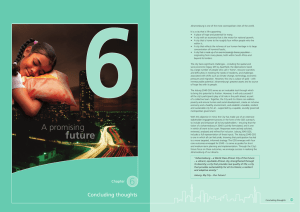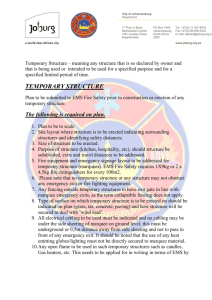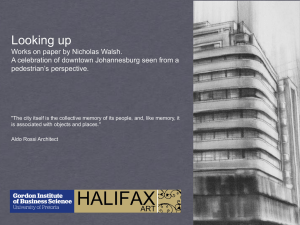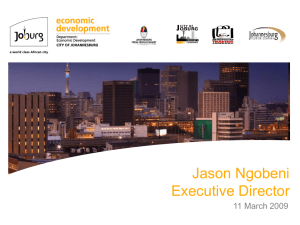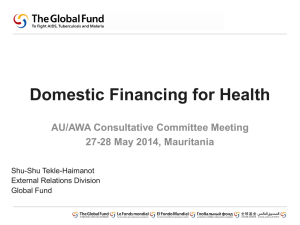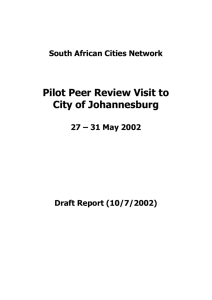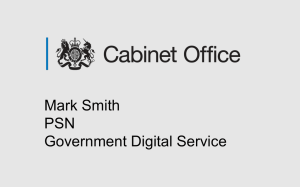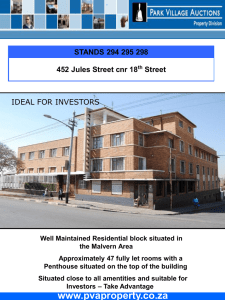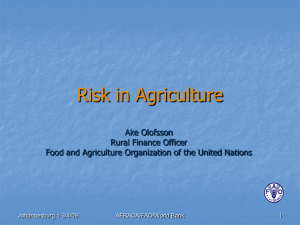Theme three - Johannesburg
advertisement
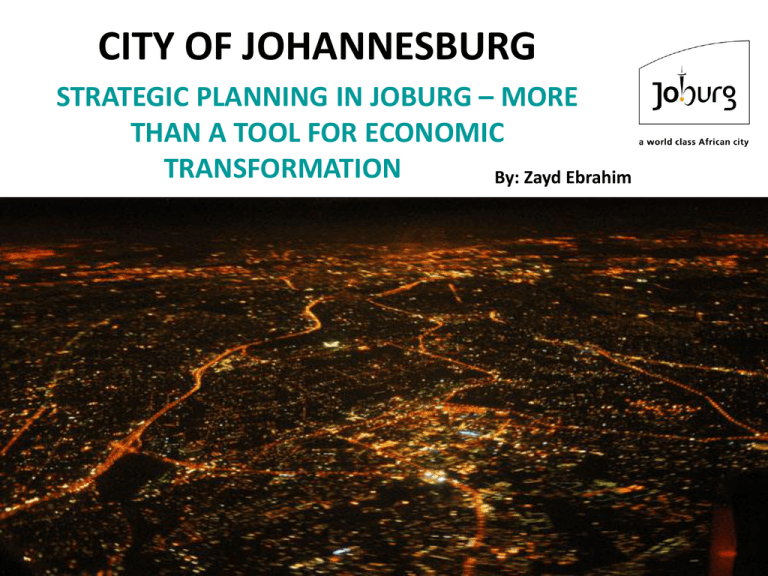
CITY OF JOHANNESBURG STRATEGIC PLANNING IN JOBURG – MORE THAN A TOOL FOR ECONOMIC TRANSFORMATION By: Zayd Ebrahim PRESENTATION STRUCTURE: •UNDERSTANDING THE CITY •CHALLENGES •OUR RESPONSE •OUTCOMES AND EXPECTATIONS •MOVING FORWARD UNDERSTANDING THE CITY JOHANNESBURG IN CONTEXT Population of Joburg was at 3.9 million in 2010 Still remains South Africa’s economic powerhouse – concentration of large industries and businesses Johannesburg generates 16% of South Africa's GDP and employs 12% of the national workforce Johannesburg is divided into seven regions Attractive to large migrant population –local and foreign UNDERSTANDING THE CITY EVOLUTION OF STRATEGIC PLANNING IN JOBURG Strategic planning is a well-entrenched practice in Johannesburg Joburg 2030 was an ambitious attempt in 2002 to link long-term economic planning to long-term growth for the City The City’s Human Development Strategy (Social development focussed) adopted in 2005 focussed on a pro-poor approach with targeted interventions for those at the doorstep of poverty The 2006 Growth and Development Strategy (GDS) was a fresh attempt at balancing pro-growth and pro-poor interventions for a city constantly in change The reviewed 2011 GDS reaffirms the developmental approach of the City’s development trajectory and proposes a new, fresh and contemporary perspective -it aligns to National Government's New Growth Path (national economic plan) aim of assisting to create five million jobs by 2020 and bring unemployment rate down to 15 per cent. The 2011 GDS is a document that covers the critical problems that face the city and proposes solutions for them, as Joburg emerges as the leading African City in financial, social, spatial and environmental terms WHAT WE NEED TO DEAL WITH JOHANNESBURG’S CHALLENGES Population is increasing at a decreasing rate - In the next 5 years, Joburg would have to accommodate 10% more residents but the population is not growing as fast due to high infant mortality and HIV/AIDS. Service delivery must continue to ensure demand of services effectively meets supply –taking into account critical funding gaps and affordability Demand for services is located in informal settlements- approximately 180 settlements mainly concentrated in the south of the city Johannesburg’s faces a quadruple resource challenge; water, electricity, fuel and food There are structural barriers to the economy that manifest in Johannesburg - while still competitive, excludes large numbers of the workforce WHAT WE NEED TO DEAL WITH JOHANNESBURG’S CHALLENGES cont… Acute skills shortages exist in most sectors of Johannesburg’s local economy. 40% of Johannesburg’s formally employed are unskilled or semi-skilled, 45% are classified as skilled and only 14% of the total working population are highly skilled. Characterized by high levels of inequality - 4 types viz: Income inequality, wealth inequality (assets formulation), social inequality (access to social and cultural services), spatial inequality (access to the built environment) Evidence of climate change impacts – more flash floods, increased rainfall in offseason months, unexpected weather patterns emerging Greater number of people, more private vehicles on the road – increased traffic congestion and greater maintenance and rehabilitation of road infrastructure OUR RESPONSE Joburg’s 2011 GDS Paradigm GOVERNANCE Sustainable Socio-Economic Environments development Service Delivery GOVERNANCE The 2011 GDS reaffirms the developmental approach of the City’s developmental trajectory This GDS charts the long-term strategic course, and makes some of the bigger, overarching decisions about what to emphasise if the City is to accelerate growth and development The paradigm balances Socioeconomic development, sustainable environments and the delivery of services under the umbrella of ensuring effective governance OUR COMMITMENT & APPROACH Guiding Principles – supported by the paradigm GOVERNANCE 1. Support the Poor 2. Sharing economic opportunities Sustainable Environments SocioEconomic development Service Delivery 3. Sustainable Human Environments 4. Resource Security & Environmental Sustainability 5. Achieving social inclusion GOVERNANCE 6. Good Governance EXPECTED OUTCOMES • The GDS takes into account measurable and relevant indicators to track • The City instituted a Performance Management System to measure operational impact and outcomes of the medium-term strategic plan (IDP) • These are in line with the goals of the revised GDS • Key outcome statements related to the guiding principles are addressed below: 1. GOOD GOVERNANCE Improved customer satisfaction, improved credit rating, eliminate corrupt activities and increased participation by citizens. 2. SUSTAINABLE HUMAN ENVIRONMENTS Improved quality of life for all. This establishes itself through higher life expectancy, literacy and income per capita (a higher human development). EXPECTED OUTCOMES 3. REDUCED ECOLOGICAL FOOTPRINT The City must be environmentally friendly to preserve the natural environment and resource base of the future generations 4. PRO-POOR SUPPORT Pro-poor support measures also ensure that communities are built where the proportion of people living below poverty line is as low as is possible. Efforts to support the poor will lead to communities where income inequality is reduced as much as possible. 5. FACILITATING JOB CREATION & ECONOMIC GROWTH Imperative to ensure that the growth of the local economy is controlled in job intensive sectors with adequate up-skilling to meet demands for the economy EXPECTED OUTCOMES – 5 YEAR SECTOR FOCUS Vision A city economy that plays a role as the key economic hub on the continent, and a national economic growth leader, by ensuring sustained shared growth that benefits all. Long-term goal 2011-2016 strategic areas Strengthen and protect key local economic sectors Facilitate economic sector skills demand and supply Promote innovation and green economic practices Facilitate the extension of cost effective broadband ICT infrastructure to all businesses Strengthen, grow and protect emerging economic practices, SMMEs and the Informal sector SMME funding and financial support SMME business support in marginalised areas SMME and informal trader education and skills development Improved public-private and public-public collaboration Leverage CoJ procurement to support emerging businesses, BBBEE, women, youth, etc Intergovernmental and international relationship building and investment promotion Identify and promote investments in line with a Joburg-wide Investment Portfolio and the UDZ Promote niche-market tourism opportunities Promote improved business infrastructure services and assets Expand Fresh Produce Market (JFPM) operations to support SMMEs and contribute to food security Strategic spatial planning to guide development/re-development Public investment framework to guide development/re-development Assessment of tariff model to ensure equity, affordability and competitiveness Facilitate job creation EPWP, internships and learnership support focusing on the Youth Labour-intensive infrastructure projects – youth focus/linkage to ESP/job pathways An efficient and effective economic information service that meets the standards of a WorldClass African City Maintenance and dissemination of economic information Undertake strategic economic research and surveys to empower decision-making MOVING FORWARD •Joburg’s long term strategy is more than just a tool for economic development – various social, spatial, environmental and financial components are strategically aligned •The City of Johannesburg remains committed to continued economic growth - Joburg was shielded from the economic downturn of 2008/9; but not immune as most job losses were in the informal sector – this was largely attributed to the construction boom as a result of the 2010 FIFA World Cup •Whilst it is necessary that the City evaluates its strategic direction given the ever changing global and local context, its economic development outcomes will never be compromised
